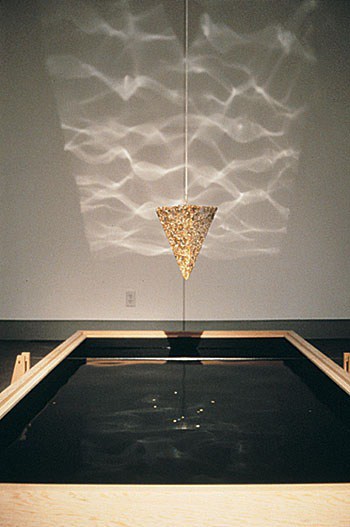The Soul’s Tempo in Four Quartets - Part 1
Rebecca Spears
 On a Friday one long-ago September, after I’d toured several galleries at the Menil Collection with some fellow writers, I was anxious to get outside and enjoy a rare, cool afternoon. However, the guide had one more exhibit to show us, a room-sized sculpture, Mineko Grimmer’s Remembering Plato.
On a Friday one long-ago September, after I’d toured several galleries at the Menil Collection with some fellow writers, I was anxious to get outside and enjoy a rare, cool afternoon. However, the guide had one more exhibit to show us, a room-sized sculpture, Mineko Grimmer’s Remembering Plato.
As soon as I entered this simple, beautiful space, I forgot my urge to rush outdoors, astounded by the sculpture: At either end of the room, a shallow, rectangular pool rested on the hardwood floor. Stretched across the middle of each basin were two wires. Over each pool, an ice pendulum encrusted with pebbles hung. Spotlights projected the water’s light and shadows onto the walls. The ice was melting; pebbles were dropping onto the wires and into the basins, producing single, musical notes and watery sounds. Simultaneously, the projections on the walls changed, as pebbles falling faster over time disturbed the water. The effect, as Menil director Ned Rifkin aptly explained, is to animate “the internal mechanism of a clock we do not ordinarily see or use, one that corresponds to the soul’s tempo. ”
The patterns on the walls figure largely too in T. S. Eliot’s Four Quartets, where Eliot examines the distance between the ideal form and a person’s changing perceptions of it over time. The quartets, “Burnt Norton,” “East Coker,” “The Dry Salvages,” and “Little Gidding,” also show us that human limitations can become a means of transcendence. If we accept the limits, exercising a measure of humility, then we may be transformed and freed of time. The quartets can be read, too, for their political context and imagery of war, but it is its narrative reflecting the poet’s conversion to Christianity that I find particularly interesting.
While the elements of Four Quartets are wide ranging, and each reader will take something different from the poems, the speaker enacts what it is like to grapple with the sublime. What I love about the quartets is Eliot’s musing on how we may glimpse eternity, where the soul experiences timelessness, and how we may seek God. I think my astonishment upon seeing Mineko Grimmer’s Remembering Plato was an exalted moment for me: I was taken out of time for a few moments and had a glimpse of something greater than myself.
In the first quartet, “Burnt Norton” (1936), the speaker’s perplexity concerning time is at once apparent: “If all time is eternally present, / All time is unredeemable.” The speaker moves toward the memory of a manor and gardens and considers the disjunction between ideal forms and reality in a positive way, namely, that the saving grace of memory is its distance from actual events. For in memory, the speaker can reconsider life and make new patterns of it.
Yet Eliot’s speaker is also bewildered, knowing that humans cannot remove themselves from time. Even when he calls on memory, he must do so in real time. There are glorious moments that humans sometimes perceive, and in those moments, movement is suspended: “The pool was filled with water out of sunlight, / And the lotos rose, quietly, quietly, / The surface glittered out of heart of light. ” Like my experience of Mineko Grimmer’s sculpture, such moments are the still point, just as the earth’s axis is its still point. Throughout “Burnt Norton,” the speaker tries to apprehend the still point where the soul can rest, while “desire itself is movement.” One reading of this quartet is the speaker’s striving for love beyond desire, a divine love, a salvation.
Eliot’s second quartet, “East Coker” (1940), moves through the seasons, which in turn give way to years, and years to ancestry and history. There is also motion toward acceptance of human limitations as well as geographic movement away from civilization toward wilderness. The movement of our time in this life is cyclical, and the speaker ponders how he might be released from it. “In my beginning is my end,” he says, recognizing that time is comprised of endless, cyclical occurrences. These are purposeless unless he—and we—begin to view them in timeless contexts.
Eliot also wants to remind us that movement through the seasons points to human frailty: though Plato’s cave-dwellers dance around the bonfire, the dance ends with the dancers. We humans fear the loss implicit in giving ourselves over to someone or something we may lose; fear of “belonging to another, or to others, or to God.” In order to acquire “the wisdom of humility,” we need to face our fears. And to gain abiding faith, hope, and love, apart from cyclical time, we must wade into the darkness. In doing this, the speaker indicates, it is possible to gain the insight of a refining fire.
Read Part II